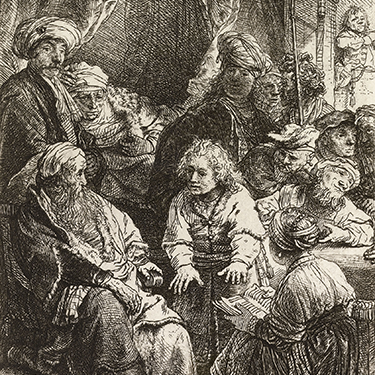M.S. Rau is committed to offering fine art of the highest caliber and we seek paintings and sculpture by historically renowned artists, often with impressive provenance. The large majority of our works of art come from private. . .
At M.S. Rau, we are committed to building a long-term, rewarding relationship with each and every client. That’s why your purchase is backed by our 125% guarantee.
Learn MoreNaked Woman on a Mound by Rembrandt van Rijn
- This important etching was created by the Dutch master, Rembrandt van Rijn
- He was known as "the etcher's god" for his mastery of the complex medium
- One of his rare nudes, this work is an intimate portrayal, showcasing Rembrandt's genius technique
- Etched by Rembrandt in 1631
- Get complete item description here
To speak to one of our experts, call 1-888-711-8084
1606-1669 | Dutch
Naked Woman on a Mound
Signed "RHL" (upper left)
Etching on paper
Etched by Rembrandt
New Hollstein 88, second state of II; Bartsch, Hollstein 198; Hind 43
One of the greatest and most celebrated artists of all time, Rembrandt has been referred to as "the etcher's god" for his remarkable mastery of the complex medium. Certainly the most important Dutch printmaker in history, his oeuvre features. . .
1606-1669 | Dutch
Naked Woman on a Mound
Signed "RHL" (upper left)
Etching on paper
Etched by Rembrandt
New Hollstein 88, second state of II; Bartsch, Hollstein 198; Hind 43
One of the greatest and most celebrated artists of all time, Rembrandt has been referred to as "the etcher's god" for his remarkable mastery of the complex medium. Certainly the most important Dutch printmaker in history, his oeuvre features nearly 300 prints, and his innovative techniques were without precedent. This superb etching, printed by Rembrandt himself and entitled Naked Woman on a Mound, displays the artistry and detail for which Rembrandt's prints are renowned.
Rembrandt depicted the female nude in just two periods of his career—during the 1630s and later in the 1650s—making works like this extremely rare. While his Italian contemporaries idealized their subjects, Rembrandt studied his models from life in informal poses, portraying them with precise naturalism—a radical departure that established new conventions for representing the human figure in Western art.
This print is exceptional in its technical virtuosity. Rembrandt's characteristic cross-hatching creates an astounding three-dimensionality, and his meticulous attention to dramatic light and shadow gives the woman a monumental sculptural quality. Scholars have debated whether she might depict a classical or biblical subject—perhaps Diana's nymph Callisto or Susanna from the Book of Daniel—but the intimacy and psychological depth captured by Rembrandt are undeniable, making this work a profound meditation on the human condition.
The son of a miller, Rembrandt van Rijn is believed to have been born in Leiden on July 15, 1606. He studied first at the Latin School and was then enrolled at the University of Leiden at the age of 14. He soon left to study art—first with a local master, Jacob van Swanenburch, and then, in Amsterdam, with Pieter Lastman, known for his historical paintings. Rembrandt was an exceptionally gifted student and mastered his art in a mere six months. Now 22 years old, he returned to Leiden and was soon so highly regarded that he was able to take students of his own.
Though known today primarily for his paintings, Rembrandt's fame spread outside the Netherlands thanks to his etchings. He made hundreds of etchings throughout his career from 1626 until 1660, the year he was forced to sell his presses. He created etchings of many subjects, including self-portraits, biblical subjects, saints and allegories, and his work was avidly admired and collected, even during his lifetime.
There are only two examples of the first state of this print known to exist today, residing at the Rijksmuseum in Amsterdam and the State Hermitage Museum in St. Petersburg. Examples of the second state, such as this print, belong to other important institutions, including the British Museum, the Museum of Fine Arts, Boston, the Yale Art Gallery, among many others.
Circa 1631
Etching: 6 3/4" high x 6" wide (17.15 x 15.24 cm)
Frame: 17 3/4" high x 14 1/4" wide x 1 1/8" deep (45.09 x 36.20 x 2.86 cm)
Provenance:
Vincent Price Art Collection
Private Collection, Louisiana, purchased from the above, circa 1980s

| Maker: | Rembrandt |
| Period: | Pre-18th Century |
| Origin: | Netherlands |
| Type: | Other Fine Art |
| Style: | Old Masters |
| Depth: | 1.13 in. (2.86 cm) |
| Width: | 14.25 in. (36.2 cm) |
| Height: | 17.75 in. (45.09 cm) |
| Canvas Width: | 6.000 in. (15.24 cm) |
| Canvas Height: | 6.750 in. (17.15 cm) |

A Golden Age: Rembrandt the Etcher
Rembrandt Harmenszoon van Rijn, known simply as Rembrandt, remains one of the important figures in art history and certainly the most significant of the Dutch Golden Age. A master in three different media,...
Read More
Shadows and Light: The Majestic World of Dutch Old Masters
Intro: In the tapestry of art history, few threads shimmer as luminously as those woven by the Dutch Old Masters. From shadowed taverns to radiant landscapes, their canvases capture a world frozen in...
Read MoreAt M.S. Rau, we are committed to building a long-term, rewarding relationship with each and every client. That’s why your purchase is backed by our 125% guarantee.
Learn More











